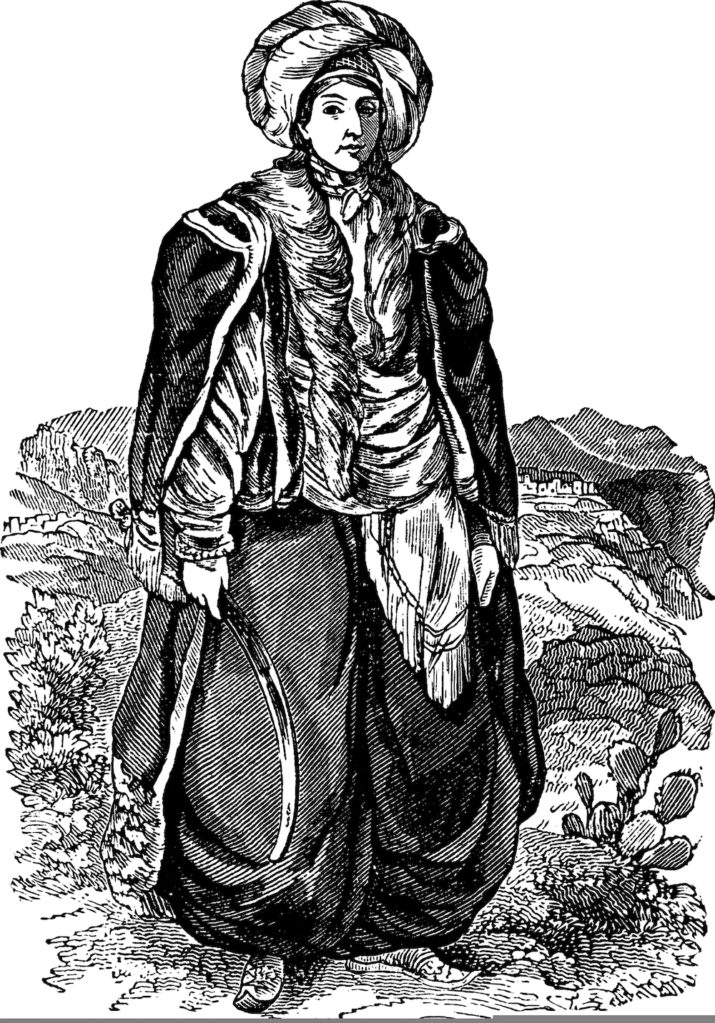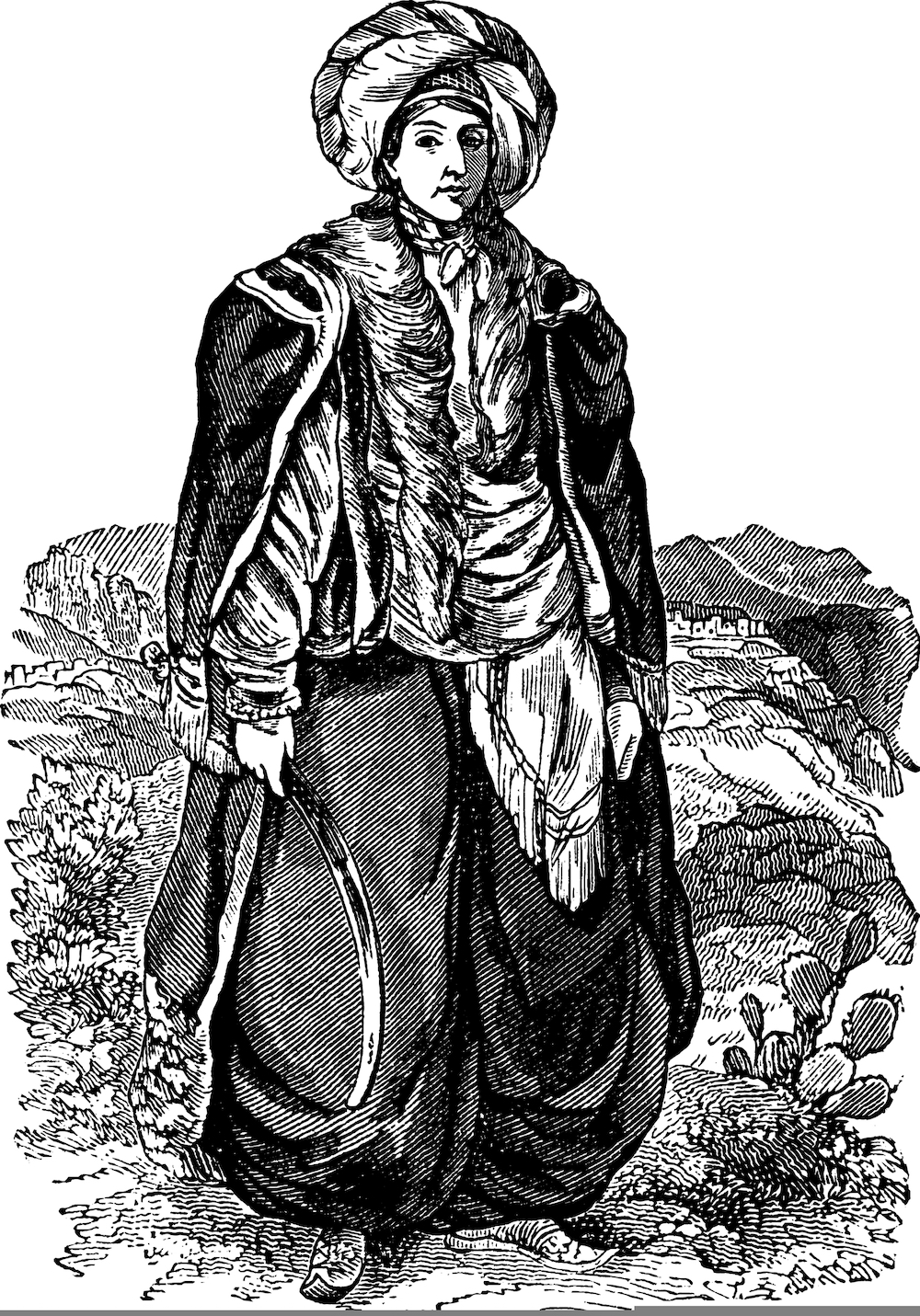
Women “Going Native” During the Early Victorian Age: The Case of Lady Hester Lucy Stanhope (1776 – 1839)

This is part of our Campus Spotlight on Maastricht University, and a Roundtable on Maastricht University Student Research.
Women’s agency in British imperialism has often been neglected in the writing of history. Their experience, roles, and identities are often dominated by male perspectives, resulting in stereotypical representation as eroticized indigenous women and white “Memsahibs” following their husbands. In recent years, however, scholars such as Mills and Bassnett have started to revise this image and to acknowledge that women’s roles were less marginal and innocent than previously assumed.[1] Women also participated in the controversial practice of “going native,” meaning that European travelers settled down outside of Europe and adapted to local customs and habits.[2] One of the main academics researching Europeans going native in and beyond the colonial empire is Brantlinger.[3] He argues that going native posed a threat to the colonial endeavor, as it undermined “white supremacy” and entailed a “racial degeneration” of the (former) colonizers. Brantlinger wrote several books[4] about this phenomenon, painting a picture of a predominantly male experience. The same applies to other works about Europeans going native,[5] even though there are more reports of women going native than Brantlinger’s (and other) research might lead us to expect.[6] Thus, I strive towards filling this gap by researching a female traveler going native outside of Europe, in the Ottoman Empire.
Lady Hester Lucy Stanhope (1776-1839) was a member of the British upper class, who left Britain in the beginning of the nineteenth century and travelled alone through Greece and the Ottoman Empire. In Britain, she had lived a life in the public eye, being the niece of Prime Minister William Pitt.[7] Throughout her life and even after her death, she was the subject of continuous public scrutiny,[8] fueled by the publication of her Memoirs in 1845.[9] Her physician Charles L. Meryon had accompanied her on parts of her journey and wrote her Memoirs about her travels and her going native after her death. Most authors retrieved their information about her from those books. Only Mitsi and Kolocotroni analyzed them in detail,[10] and even they rather saw Lady Hester as a case study of how women were represented in the colonial discourse, as most academics did.[11] Her going native has not been studied yet, which is exemplary of the general lack of research into women going native. As the Memoirs are written by her physician Meryon, it is difficult to make inferences about Lady Hester’s actual agency in going native. However, it is possible to study how she was perceived by a male contemporary through the dominant lenses of the early Victorian age. Hence, my research explored how Meryon framed Lady Hester as a female traveler going native in the early nineteenth century in the Memoirs. I used Critical Discourse Analysis and framing as the research methodology, as it reveals “that both grammar and choice of words in a text convey information about the world view expressed in that text.”[12] Through an analysis of Meryon’s framing, I detected the tensions Lady Hester caused by going native in the eyes of a male contemporary.
Rediscovering gender in imperial history
Before the feminist revival in the 1970s, imperial history was little concerned with women’s agency and their experiences.[13] As Midgley notes, the study of male-dominated domains, as colonial policymaking and administration, was much more in the foreground, and the focus only slowly shifted towards gender history.[14] The study of culture as well as the inclusion of the domestic sphere into imperial research led to the emergence of the field of “New Imperial History.”[15]New foci emerged and debates started, for instance about female agency in imperialism.[16] The idea that imperialism had an inherent gender component to it, which would have to be taken into consideration, slowly gained acceptance. Exploring the variety of female colonial experiences also contributes to, as Whitlock puts it, the correction of the “idea of a transhistorical female experience,”[17] to avoid generalizing female colonial experiences, as has happened in past debates. This research is thus situated within new imperial history’s preoccupation with gender and contributes to an understanding of contemporaneous views on women challenging established norms by going native in imperialism.
Since the case study is located in the former Ottoman Empire, Said’s Orientalism[18] is used to conceptualize the analysis. Lady Hester did not simply “settle down” somewhere, but she went native in a place outside Europe, that was heavily stereotyped by Western perceptions. The region Europeans call the Middle East nowadays was denoted as the “Orient” in the early nineteenth century. This was a place where Europeans constructed their counterpart, the “Other,” in order to differentiate themselves.[19] Even though the “Orient” was not part of a formal British empire, it belonged to a more “informal” one, in which the British tried to establish their influence. The informal empire was not secured through the annexation of territories, but through trade relations, for instance with Persia and the Ottoman Empire.[20] Feeling superior towards other cultures and nations, inherent to the “white supremacy” ideology, and dominating people outside one’s own nation-state, was also part of European’s behavior in the “Orient.”[21] Thus, this thesis contributes to the field of European Studies by shining a light upon European imperialism beyond the formal colonized territories. As Hobsbawm[22] argues, Britain was one of the most powerful nations influencing the fate of the rest of the world in the nineteenth century. An analysis of their imperial project thus helps to understand how it shaped the world we are living in today.
Lady Hester’s racial degeneration in the Ottoman Empire
Lady Hester was born into British culture, which made her, in the eyes of fellow expats in the Ottoman Empire, superior to the local population. According to Brantlinger, this superiority was seen as being jeopardized by going native, as it would cause a “racial degeneration.” It was thought to undermine the justification for the oppression and paternalism of the local population. Her British upper-class status, and thus her morally superior status in British society, further intensified those tensions, as her fall down the social ladder was worsened. This can be seen throughout the Memoirs: Meryon not only describes how she went native in his eyes (e.g. how she adapted to Syrian customs),[23] but simultaneously relativized it by questioning her mental health.
Meryon repeatedly suggests that Lady Hester’s health was not in a good state.[24] For instance, he writes that “sometimes, one was almost forced to conclude that the constant workings of her brain had impaired it.”[25] Thus, he presents her active mind as being responsible for her damaged health. Especially women were thought to jeopardize their health by having a “too active” mind and being exposed to controversial debates.[26] Having an impaired health is also an aspect of the supposed “racial degeneration” Brantlinger referred to.[27] In his authority as her physician, his diagnosis would not be questioned by his readers. Thus, by ascribing impaired health to Lady Hester, her behavior could be put into perspective. One could say, that Meryon tries to naturalize her going native by pathologizing it. With this strategy, he presents her behavior as harmful and thus discourages other women to follow Lady Hester’s example.
Another aspect that is visible throughout the book is Meryon’s perception of Lady Hester’s social degeneration through her going native. In his eyes, she descended on the social ladder, adopting a similar standard of living as “commoners.” This can be seen through his use of negative connotated adjectives when denoting her furniture as “rude,” “hardly better than a common peasant’s,”[28] and in all his descriptions of her furnishing, as well as her clothes (e.g. as “dirty,”[29]“common,”[30] “poor,”[31] “tattered,”[32] “ragged”[33]). Meryon connects the adjective “common” often with local customs,[34] or elements he characterizes as being Syrian,[35] implying that her social degeneration was due to her going native and assimilation to this inferior culture. Belonging to this “inferior” race is connected here to a lower social class, an interplay that supports the intersectionality theory first formulated by Crenshaw.[36] Her theory highlights that especially Black women were not only marginalized based on their sex but also in interplay with their race. Since then, intersectionality theory has been broadened and has become the dominant framework for scrutinizing the intersections of the various categories defining social identities.[37] This section has illustrated how Meryon frames Lady Hester’s going native: he implies that she was mentally ill, even racially degenerated, and simultaneously descended on the social latter by going native. Meryon’s framing proves that Lady Hester’s going native caused tensions with the imperialist ideology, and more specifically with the supposed “white supremacy.”
Victorian gender norms challenged to the utmost
The Victorian age was characterized by its rigid gender perceptions,[38] which were only gradually challenged in the later nineteenth century. In the Memoirs, Meryon contrasts Lady Hester with British women that fulfilled the prevailing gender roles as the “Angel in the House,” pointing out their differences in behavior and character. Lady Hester is rather described with male attributes, as being restless, even dominant and commanding. This corresponds to the word-clusters of adjectives that Meryon uses throughout the book when describing her character and manners: most notably “vigour,”[39]“loud,”[40] and even “violent.”[41] Those are characteristics not suited to describe a Victorian woman, especially since “violent” is more commonly associated with strength, overbearing temper and danger, mainly masculine features. Women were supposed to find their fulfilment in the private sphere and not having “a spirit so restless.”[42] Her behavior did not fit into his worldview, again, and she continuously challenged his gender norms.
When talking about other British women, Meryon emphasizes their womanly qualities, for instance, being “a model of virtue and goodness.”[43] As Steinbach points out, in the Victorian gender perception, the woman was confined to the private space, setting moral standards by keeping the house and children together.[44] Lady Hester never married or gave birth to children, which made her stand out and could yield her the reputation of a “Spinster.” However, Meryon does admit that she uses her “active and benevolent”[45] mind for the greater good of the community, bringing “relief to the poor and oppressed.”[46] So even though she is different than other women, it could be partly excused as she helps less fortunate souls. Interestingly, Meryon tries to highlight the fact that, even though Lady Hester was wearing Turkish male clothes,[47] she was considered to be very beautiful in Britain before her departure.[48] This implies that only the going native had transformed her into this strange, violent, cross-dressing “Spinster Abroad.”
Her “active imagination,”[49] as well as her temper, was not constrained by British society anymore since she went native: “Her peculiar character, released from the control of law and opinion, which restrained the development of her natural temper in England, was here enabled to give free vent to her disposition with perfect impunity.”[50] Meryon implies that she only became so “peculiar”[51] because she went native and the British gender perceptions did not constrain her anymore. Thus, this seems to be one of the differences between women and men going native. Women’s temper and active imagination needed to be controlled, to prevent them from becoming mentally ill like Lady Hester. When they went native, this control was lost, while men had more leeway in their actions already. Since women were supposed to be in a morally higher position than men anyway (“Angel in the House”), their fall down the social ladder, by adapting to the “uncivilized” natives, was even worsened. This section has illustrated that a woman’s going native also challenged the prevailing gender discourse. Especially in Brantlinger’s studies, the gender aspect in European’s going native has not been researched that much.
Not all “white supremacy” is lost
So far, I have argued that, through presenting Lady Hester as mentally ill, Meryon tries to frame the tensions she caused with her going native. This would support Brantlinger’s argument that contemporaries viewed going native as undermining the racial ideology, and especially the “white supremacy” aspect. However, I argue that even though Lady Hester tried to exit the imperialist framework with its inherent gender norms, she did not manage to completely cast it off. This section shows that—in Meryon’s framing—she took the imperialist worldview with her when trying to “turn into one of them.” Even though she challenged the imperialist ideology, she preserved some of her racial superiority in Meryon’s eyes.
When Lady Hester went native at Mount Lebanon in the Ottoman Empire, she still occupied a special position in the local hierarchy, as she claimed to be part of a “noble, Arabian tribe.”[52] She also did not fully assimilate to the local culture, as she was only able to speak insufficient Arabic[53] and conducted her household affairs in English.[54] Lady Hester was also still very much bound by being part of a European expat elite.[55] Thus, even though Meryon frames her as going native, it also becomes clear that she took parts of her “Europeanness” with her. Additionally, Meryon frames her as taking her upper-class status with her when going native, as servants still called her “mylady.”[56] It shows that she did not move down the social ladder as much as Meryon had tried to convey to the reader earlier. She was still superior to the local population, as she had “extraordinary influence over her dependents.”[57]
Meryon also frames her as still being intellectually superior to the “haughty Mussulman.”[58] This generalization demonstrates the intellectual dominance of the British and the moral degradation of the local population. It corresponds to the image of the “lying natives,” who needed to be taught how to behave properly by Europeans as Lady Hester.[59] This theme appears more often in the Memoirs and hints at a specific metaphor: the native as a child. Colonialist discourse has been deeply characterized by this logic of “white supremacy,” describing natives as underdeveloped, who need protection and benevolence by their colonizers.[60] It also evokes this often-occurring image of Europeans taking self-declared responsibility to save and correct the “lying natives.” This justified a logic of dominance and permanent oppression, as colonized people are, in contrast to the ideal of white children, unable to develop further and thus stuck in this phase forever.[61] By framing Lady Hester as still being superior to the “lying, child-like natives,” Meryon implies that she has not completely “lost” her superiority.
Those descriptions not only exemplify the imperial discourse that constrained Lady Hester but also reinforce the notion of a hostile and delinquent “Orient.” Not only the environment and nature were inaccessible and dangerous, putting great strains on travelers and inhabitants,[62] but also the people surrounding Lady Hester were dishonest and corrupt. Thus, Meryon achieves to paint a dark, hostile picture of the “Orient,” which can only be made habitable by the hand of Europeans, especially through educating and fostering its local population. He excludes Lady Hester from those generalizations, and thus frames her as not being on the same level as the local Syrian population. Even though Lady Hester did go native, she took parts of her intellectual dominance (over the local “Orient” population) with her. Thus, Brantlinger’s argument, that going native undermined imperialism, because Europeans racially degenerated, needs to be more nuanced, as it seems to be very generalizing. Going native does involve social degradation, but my argument proposes that parts of the racial superiority are still preserved. Analyzing this one case of a woman going native has already shown that our picture of going native needs to be more nuanced.
Through a case study, this research illustrates the need for further studies about women going native to complete the existing picture. Gender ideologies play a different role for women going native, and their class also needs to be taken into consideration. Further research should investigate sources written by women themselves, as this would be especially revealing of their actual agency in imperialism. Lady Hester is a popular example of a woman going native, challenging imperialist and gender discourse. By recovering a woman’s role in imperialism, this research shows how powerful and influential the imperialist framework, and its gender norms, was on individual behavior.
Johanna Hvalić recently finished her BA in European Studies at Maastricht University in the Netherlands. She is now starting her Master of Arts in Gender Studies at Makerere University in Kampala, Uganda.
References:
[1] e.g. Sara Mills, Discourses of Differences: An Analysis of Women’s Travel Writing and Colonialism (London: Routledge, 1993); Susan Bassnett, “Travel Writing and Gender”, in The Cambridge Companion to Travel Writing, eds.Peter Hulme & Tim Youngs (Cambridge: Cambridge University Press, 2012), 225-241.
[2] Patrick Brantlinger, Victorian Literature and Postcolonial Studies (Edinburgh: Edinburgh University Press, 2009), 85.
[3] Patrick Brantlinger, Taming Cannibals: Race and the Victorians (Cornell: Cornell University Press, 2011).
[4] See notes 3 and 4, additionally Patrick Brantlinger, Rule of Darkness: British Literature and Imperialism, 1830-1914(Cornell: Cornell University Press, 1988).
[5] Daniel B. Thorp, “Going native in New Zealand and America: Comparing Pakeha Maori and White Indians”, The Journal of Imperial and Commonwealth History 32, no. 3 (2003): 1-23; A. Irving Hallowell, “Papers in Honor of Melville J. Herskovits: American Indians, White and Black: The Phenomenon of Transculturalization”, Current Anthropology 4, no. 5 (1963): 519-531; William Dalrymple, “Porous Boundaries and Cultural Crossover: Fanny Parkes and “Going native”, in Travel Writing and the Empire, ed. Sachidananda Mohanty (New Delhi: Katha, 2003), 42-62.
[6] see e.g. Jessica M. Howell, “Nurses going native: Language and identity in letters from Africa and the British West Indies”, The Journal of Commonwealth literature 51, no. 1 (2015): 165-181.
[7] See for example George Paston, Little Memoirs of the Nineteenth Century (London: Grant Richards, 1902); “Lady Hester Stanhope” Encyclopaedia Britannica. 1911. https://en.wikisource.org/wiki/1911_Encyclop%C3%A6dia_Britannica/Stanhope,_Lady_Hester_Lucy.
[8] “VEILED PROPHETESS… Career of Englishwoman” Australian Women’s Weekly. 9 December 1933.https://trove.nla.gov.au/newspaper/article/51188872; Lidia Curti, Female Stories, Female Bodies: Narrative, Identity and Representation (New York: new York UP, 1998); Billie Melman, Women’s Orients: English Women and the Middle East, 1718-1918 (London: Palgrave MacMillan, 1992); Hsu-Ming Teo, “Women’s Travel, Dance and British Metropolitan Anxieties, 1830-1939”, Gender & History 12, no. 2 (2000): 366-400.
[9] Charles L. Meryon, Memoirs of the Lady Hester Stanhope, as related by herself in conversations with her physician: comprising her opinions and anecdotes of some of the most remarkable persons of her time (London: Henry Colburn, 1845), Vols. 1-3.
[10] Efterpi Mitsi and Vassiliki Kolocotroni (eds.), Women Writing Greece: Essays on Hellenism, Orientalism and Travel(New York: Rodopi, 2008).
[11] e.g. Curti, 1998; Melman, 1992; Teo, 2000
[12] Kristina Boréus and Göran Bergström, Analysing text and discourse. Eight Approaches to Discourse Analysis(London: Sage Publications, 2017), 8.
[13] Clare Midgley (ed.), Gender and Imperialism (Manchester: Manchester University Press, 1998), 6.
[14] Midgley, 1.
[15] Tony Ballantyne and Antoinette Burton (eds.), Moving Subjects: Gender, Mobility, and Intimacy in an Age of Global Empire (Illinois: University of Illinois Press, 2009).
[16] e.g. Suzanne M. Spencer-Wood, “Feminist Theorizing of Patriarchal Colonialism, Power Dynamics, and Social Agency Materialized in Colonial Institutions”, International Journal of Historical Archaeology 20 (2016): 477-491; Catherine Hall, Civilising Subjects: Colony and Metropole in the English Imagination (Chicago: University of Chicago Press, 2002).
[17] Gillian Whitlock, The Intimate Empire: Reading Women’s Autobiography (New York: Cassell, 2000), 3.
[18] Edward Said, Orientalism (New York: Pantheon, 1977).
[19] Said, 3-6.
[20] James Onley, “Britain’s Informal Empire in the Gulf, 1820 – 1917”, Journal of Social Affairs 22 (2005): 34.
[21] Said, Orientalism, 2.
[22] Eric Hobsbawm, The Age of Empire: 1875 – 1914 (London: Weidenfeld & Nicolson, 1987).
[23] e.g. Meryon, Memoirs of the Lady Hester Stanhope, 4, 24, 119,196, 226, 275, 279, 291.
[24] Meryon, 12, 23, 36, 82, 228, 346, 351, 371.
[25] Meryon, 199.
[26] e.g. Marlene Tromp, The Private Rod: Marital Violence, Sensation, and the Law in Britain (Charlottesville: University Press of Virginia, 2009), 106-107.
[27] Brantlinger, Taming Cannibals: Race and the Victorians, 67.
[28] Meryon, Memoirs of the Lady Hester Stanhope, 123.
[29] Meryon, 124.
[30] Meryon, 123, 124, 127.
[31] Meryon, 101, 120.
[32] Meryon, 100.
[33] Meryon, 100.
[34] Meryon, 298.
[35] e.g. “the common flooring of Syria”, Meryon, 123.
[36] Kimberle Crenshaw, “Demarginalizing the Intersection of Race and Sex: A Black Feminist Critique of Antidiscrimination Doctrine, Feminist Theory and Antiracist Politics”, University of Chicago Legal Forum 1 (1989), 139-168.
[37] Devon Carbado, Kimberle Crenshaw, Vickie M Mays, & Barbara Tomlinson, “Intersectionality: Mapping the Movements of a Theory”, Du Bois Review: Social Science Research on Race 10, no. 2 (2013): 303-312.
[38] Susie L. Steinbach, Understanding the Victorians (London: Routledge, 2012).
[39] Meryon, Memoirs of the Lady Hester Stanhope, 96, 128.
[40] Meryon, 222.
[41] Meryon, 4, 97, 128.
[42] Meryon, 129.
[43] Meryon, 158.
[44] Steinbach, Understanding the Victorians.
[45] Meryon, Memoirs of the Lady Hester Stanhope, 129.
[46] Meryon, 129.
[47] Meryon, 99.
[48] Meryon, 181.
[49] Meryon, 154.
[50] Meryon, 223.
[51] see also Meryon, 123, 332.
[52] Meryon, 9.
[53] Meryon, 28, 200.
[54] Meryon, 342.
[55] Meryon, 94.
[56] Meryon, 342.
[57] Meryon, 78.
[58] Meryon, 248.
[59] Meryon, 112, 130, 350.
[60] China Mills and Brenda A. Lefrancoise, “Child as Metaphor: Colonialism, Psy-Governance, and Epistemicide”, World Futures: The Journal of New Paradigm Research 74, no. 7-8 (2018): 503-524.
[61] Clare Barker, Postcolonial fiction and disability: Exceptional children, metaphor and materiality (London: Palgrave MacMillan, 2011).
[62] Meryon, Memoirs of the Lady Hester Stanhope, 211, 227, 254, 325, 347.
Photo: Lady Hester Stanhope, vintage illustration | Shutterstock
Published on November 10, 2020.




